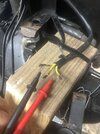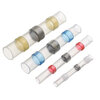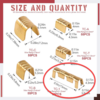It's an old thread but I hope you don't mind me posting in it. I am about to buy a Honda ST 1300 because I can't trust my old 1996 Honda shadow 1100 anymore. The latest breakdown that left me alongside the road calling for a tow truck ....or more correctly my brother with his landscape trailer....
...was a charred and melted "three yellow wire" connector between the stator and the regulator rectifier.
I snipped the wires and took the offending connection out, and on the RR side I only have about 3/4 of an inch of insulated wire stubs before those wires disappear into the wiring harness of the bike.
It looks like I would have to disassemble the motorcycle more than I would like to access these properly for soldering, so I'm thinking of crimping the wires together with a butt connector made for 12 gauge multi strand wire,
and then double-layer heat shrinking them.
OR MAYBE.... if I can solder in such a confined space...
lightly putting the wires in the metal butt connector first,
heating that connector up until both the connector and the copper wires are hot enough to melt rosin-core solder,
soldering the wires to the butt connector,
crimping them ( crushing the lead and the copper and brass all tightly together)
and then finally heat-shrink wrapping it.







